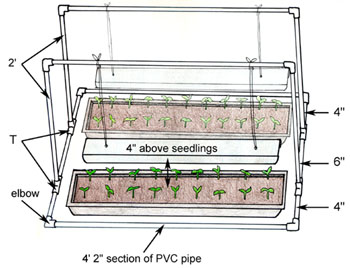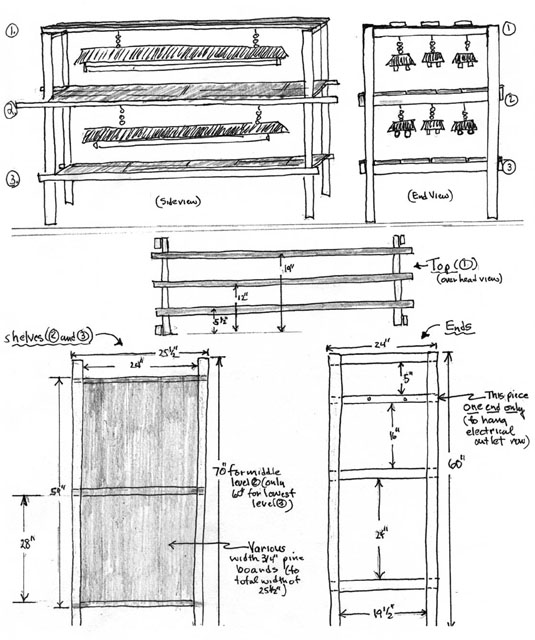Bulletin #2763, Container Gardening Series: Garden Equipment and Items to Make for the Maine Garden
Developed by Associate Extension Professors Donna Coffin, Kathy Hopkins, Frank Wertheim, and Extension Agriculture Coordinator Casey Bowie. Reviewed by Marjorie Peronto.
For information about UMaine Extension programs and resources, visit extension.umaine.edu.
Find more of our publications and books at extension.umaine.edu/publications/.
Square Newspaper Pots for Seedlings
Be sure to place your finished pots on a waterproof tray, since the bottoms of these pots will decompose as your seedlings are growing.
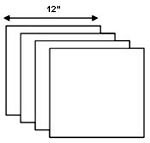
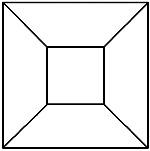
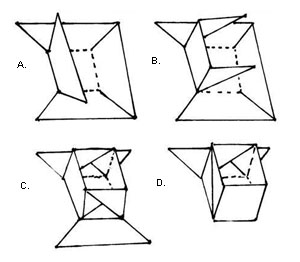
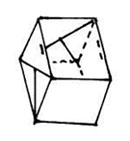
— Illustrations by Donna Coffin.
Round Newspaper Pots for Seedlings
You will need a can with a rim, and four layers of newspaper cut into 4″-wide strips that are as long as possible.
- Wrap the can with the newspaper strips, taping the strips together where they overlap. Be sure to leave two inches of the newspaper below the bottom of the can.
- Fold the newspaper under the bottom of the can. Tap the wrapped can on a solid surface to flatten the bottom of the newspaper pot.
- Slip the newspaper pot off the can and tape to secure. Be sure to put newspaper pots on a waterproof tray since the bottoms will disintegrate before your seedlings are ready to transplant.
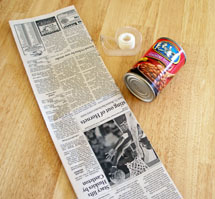
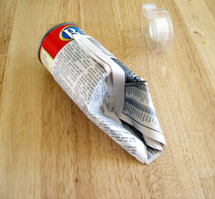
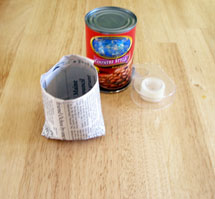
— Photos by Donna Coffin
PVC Light Stand for Seedlings
Materials list for PVC light stand
Using three sections of 10′ 3/4″ diameter PVC pipe
- 4 pieces of 4′ 2″ PVC pipe
- 4 pieces of 2′ PVC pipe
- 2 pieces of 6″ PVC pipe
- 4 pieces of 4″ PVC pipe
- 8 right-angle sections 3/4″ PVC pipe
- 4 (3/4″) T sections of PVC pipe
- 2 shop lights with one cool and one warm white light bulb each
- 4 pieces of 1 1/2″ chain to hang lights
- Timer for lights
Two-Tier Seedling Stand
Materials list for two-tier seedling stand
Use of 1″ x 3″ wood strapping is recommended for the frame. Strapping is inexpensive, strong, and usually comes in bundles of 10 pieces, in either 6′ or 8′ lengths. One bundle of 6′ pieces will be more than enough to make a frame.
1′ x 3″ strapping:
- Two 70″ pieces (for the level-2 shelf frame — the extra length gives you a handle)
- Nine 60″ pieces (3 of these are to hang the top lights; 4 are for the two end frames, bottom right; 2 are for the bottom shelf frame)
- Eleven 24″ pieces (3 for each of the two shelves, 3 for one end frame, 4 for the second end frame, allowing you to attach an electrical plug strip to the one marked as such)
- Wood for the two shelves, which can be made of any material: old pine planking, 1/2″ or 3/4″ plywood, or whatever you have on hand. You will need enough to cover the two shelves’ frames, each shelf being 24″ wide by 60″ long.
- 12 cup hooks to hold the chains for the lights. Two on each of the 3 top light-hanging pieces of strapping for hanging lights over shelf number 2. The other 6 go on the bottom shelf number 2 to hang the 3 sets of lights for shelf number 3.
- 1 5/8″ sheetrock screws for construction.
- One plug strip to attach to the frame and plug your lights and seedling heat mat into.
- One timer to plug the light strip into (set for 16-hour days).
- 6 sets of shop lights. Buy the ones that come with chains. They are the cheapest, usually ranging from $7–10 each. If you like, start with 3 sets of shop lights for the top shelf, and buy 3 more when you expand onto the lower level.
- Recommended: a seedling heat mat.
Cold Frame
Materials list for cold frame
- 27′ of 1″ x 12″ dimensional lumber
- 8′ of 2″ x 2″ dimensional lumber
- 24′ of 1″ x 3″ wood strapping
- 21′ of 1/4″ x 1 1/2″ wood lath
- 6 metal corner angles, 3″ x 3″
- 3 metal hinges, 3/4″ x 3″
- 1 sheet 6 mil plastic (polyethylene),
- 4″ x 6″
- 30 #10 flat head wood screws, 1 1/2″
- 3 oz. 3/4″ wire nails
- 1 qt. white paint
- Use hardwood if possible, as it will last longer than softwood. Paint all wood with white paint.
- Line with 1″ board insulation, if desired.
- Build up soil on the outside to help insulate.
- Cover at night with blanket or insulation to extend the growing season.
- Can be disassembled and stored after the growing season.
Raised Bed
Materials list for one 4′ x 8′ raised bed
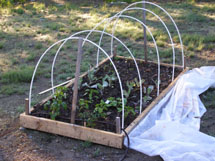
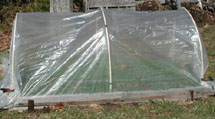
- 24 board feet of 2″ x 10″ rough-cut planking: 2 pieces 4′ long; 2 pieces 8′ long
- 1 piece of rigid 1 1/4″ PVC pipe for holding hoop: comes in 10′ length; cut 6 pieces to 10″ lengths
- 12 (or one packet) of 1 1/4″ pipe brackets — for attaching 10″ rigid PVC pieces to planking
- 3 flexible PVC pipes, 1/2″ x 10′ — for making hoops. Cut with a hacksaw to 9′ lengths.
- 4 pieces of 8′ long 1″ x 3″ strapping — for creating channels to hold poly
- 1 sheet of 4 mil polyethylene plastic, 10′ x 15′
- 2 pieces of 8′ lath — for holding plastic in channel
- 4–8 hardware clamps
- 6 pieces of 6″ long 1″x 3″ strapping scraps — for turn buttons
- Sheetrock screws — for holding turn buttons on the bottom piece of strapping
Optional materials for vertical growing:
- 3 electrical conduit pipes, 10″ long x 5/8″ — for holding trellis
- 8′ strapping for trellis crossbar
- 1 piece 4″ x 4″ netting, 8′ x 6′ — staple to strapping and bolt strapping to pipe.
Plant in a Bag
Materials list for plant in a bag
- 1 bag (at least 8 qt.) of either soilless growing medium or potting soil
- Water-soluble fertilizer
- Knife to cut holes
Directions:
Open the bag of growing medium and mix with enough water to make the medium moist but not wet. Fold the top of the bag over and cut drainage slits in the bottom. Flip bag over and cut a large X in the middle of the top; plant seedling through a hole. Cut smaller X in one corner and put a full bottle of water upside down in the hole with the cap off, sinking the top of the bottle into the growing medium. Refill water bottle with water containing soluble fertilizer as needed.
Celery Blancher
Cardboard milk cartons can be used on individual celery plants to blanch the stalks, which makes them more tender. Just cut the bottom off the carton of milk, open up the top, and carefully slide the carton over the celery plant when it is about a foot tall.
Planting Holes in Plastic
Use a propane torch to make planting holes in plastic. Care must be taken to regulate the size of the hole and assure that only the heat from the flame melts the plastic. Put out any flames immediately if plastic starts to burn.
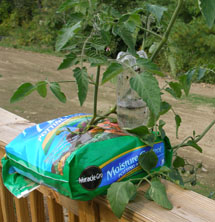
Photo by Donna Coffin
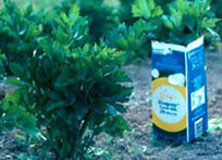
Photo by Donna Coffin
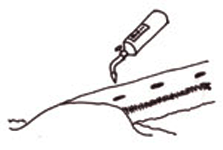
Illustration by Donna Coffin.
Information in this publication is provided purely for educational purposes. No responsibility is assumed for any problems associated with the use of products or services mentioned. No endorsement of products or companies is intended, nor is criticism of unnamed products or companies implied.
© 2009
Call 800.287.0274 (in Maine), or 207.581.3188, for information on publications and program offerings from University of Maine Cooperative Extension, or visit extension.umaine.edu.
In complying with the letter and spirit of applicable laws and pursuing its own goals of diversity, the University of Maine System does not discriminate on the grounds of race, color, religion, sex, sexual orientation, transgender status, gender, gender identity or expression, ethnicity, national origin, citizenship status, familial status, ancestry, age, disability physical or mental, genetic information, or veterans or military status in employment, education, and all other programs and activities. The University provides reasonable accommodations to qualified individuals with disabilities upon request. The following person has been designated to handle inquiries regarding non-discrimination policies: Director of Equal Opportunity and Title IX Services, 5713 Chadbourne Hall, Room 412, University of Maine, Orono, ME 04469-5713, 207.581.1226, TTY 711 (Maine Relay System).


